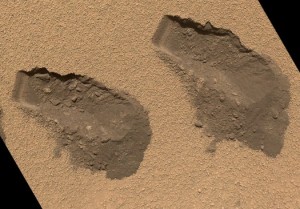Curiosity has been analyzing rocks on Mars for a while now. Popular Science updates on it’s findings:
The presence of perchlorate may be the biggest news from the press conference, which kicked off the day at the American Geophysical Union’s fall meeting in San Francisco. The Mars Phoenix lander also saw evidence of this chlorine-oxygen compound, which could conceivably be used as an energy source by Martian microbes. The analysis of these chemicals–which involves baking samples inside SAM’s oven and measuring the vapors that come out–in and of itself created new chemicals which the sensitive instruments picked up. Among those newly formed chemicals were some chlorinated methane compounds.The chlorine is from Mars, Mahaffy said. The carbon’s origin is still unclear. Scientists will try to figure it out by measuring isotope ratios and making other measurements.
Other results from Curiosity’s first few months on Mars include some analysis of the soil and rocks, which are apparently very similar in both chemical composition and appearance to rocks in other spots on the planet. The Pathfinder, Spirit and Opportunity rovers saw very similar soil in different locations. At Curiosity’s present location, a site in Gale Crater called Rocknest, the soil is about half volcanic material and half crystalline materials, like glass. Interestingly, the water bound up in this soil is much, much heavier than water in Earth’s oceans, Mahaffy said.
So no extraterrestrial life just yet. But the data is still pouring in.

Comments are closed.